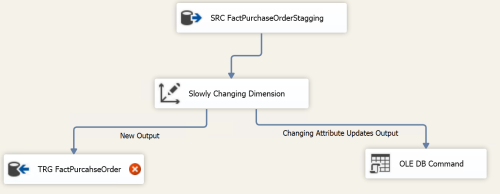Cursors are not supported on a table which has a clustered columnstore index
-
November 21, 2018 at 8:57 am
Hello,
I'm using OLE DB connection in SSIS, which inserts the data into SQL Server Table. I'm follwing getting error
"Cursors are not supported on a table which has a clustered columnstore index".
How do I resolve that?Appreciate your help.
-
November 21, 2018 at 9:01 am
irehman - Wednesday, November 21, 2018 8:57 AMHello,I'm using OLE DB connection in SSIS, which inserts the data into SQL Server Table. I'm follwing getting error
"Cursors are not supported on a table which has a clustered columnstore index".
How do I resolve that?Appreciate your help.
Stop using a cursor!
Michael L John
If you assassinate a DBA, would you pull a trigger?
To properly post on a forum:
http://www.sqlservercentral.com/articles/61537/ -
November 21, 2018 at 9:02 am
irehman - Wednesday, November 21, 2018 8:57 AMHello,I'm using OLE DB connection in SSIS, which inserts the data into SQL Server Table. I'm follwing getting error
"Cursors are not supported on a table which has a clustered columnstore index".
How do I resolve that?Appreciate your help.
Look at your code and determine if the cursor is actually needed by looking to see if there is a set-base solution.
-
November 21, 2018 at 9:06 am
irehman - Wednesday, November 21, 2018 8:57 AMHello,I'm using OLE DB connection in SSIS, which inserts the data into SQL Server Table. I'm follwing getting error
"Cursors are not supported on a table which has a clustered columnstore index".
How do I resolve that?Appreciate your help.
Can you expand on exactly what this OLEDB connection is being used for within the package?
If you haven't even tried to resolve your issue, please don't expect the hard-working volunteers here to waste their time providing links to answers which you could easily have found yourself.
-
November 21, 2018 at 9:09 am
Simply inserts the data from One SQL Table to another
-
November 21, 2018 at 9:11 am
irehman - Wednesday, November 21, 2018 9:09 AMSimply inserts the data from One SQL Table to anotherIf all it is doing is moving data from one table to another, you really need to look at a set-based solution.
-
November 21, 2018 at 9:15 am
irehman - Wednesday, November 21, 2018 9:09 AMSimply inserts the data from One SQL Table to anotherSo this is a dataflow with a standard OLEDB source and destination?
Are you using OLEDBCOMMAND at all?
If you haven't even tried to resolve your issue, please don't expect the hard-working volunteers here to waste their time providing links to answers which you could easily have found yourself.
-
November 21, 2018 at 9:19 am
yes
-
November 21, 2018 at 9:23 am
Here is the flow

-
November 21, 2018 at 9:30 am
If you disable the OLEDBCommand, does the error stop happening?
If yes, you need to reengineer your package. Direct the 'changing' rows to a work table and then call a stored proc at the end to perform all of the updates in one hit (this is what set-based solutions do).
If you haven't even tried to resolve your issue, please don't expect the hard-working volunteers here to waste their time providing links to answers which you could easily have found yourself.
-
November 21, 2018 at 9:39 am
I deleted the OLE Command, rebuild and still the same issue.
-
November 21, 2018 at 9:49 am
OK, not sure what to do next.
I have no trouble loading a table with a NONCLUSTERED columnstore index using SSIS OLEDB source and target, so if that's an option it may be worth a try (I am using 2017, so if you are on a lower version, behaviour may be different).If you haven't even tried to resolve your issue, please don't expect the hard-working volunteers here to waste their time providing links to answers which you could easily have found yourself.
-
November 21, 2018 at 9:56 am
Which version of SQL Server are you using?
If you haven't even tried to resolve your issue, please don't expect the hard-working volunteers here to waste their time providing links to answers which you could easily have found yourself.
Viewing 15 posts - 1 through 15 (of 19 total)
You must be logged in to reply to this topic. Login to reply
